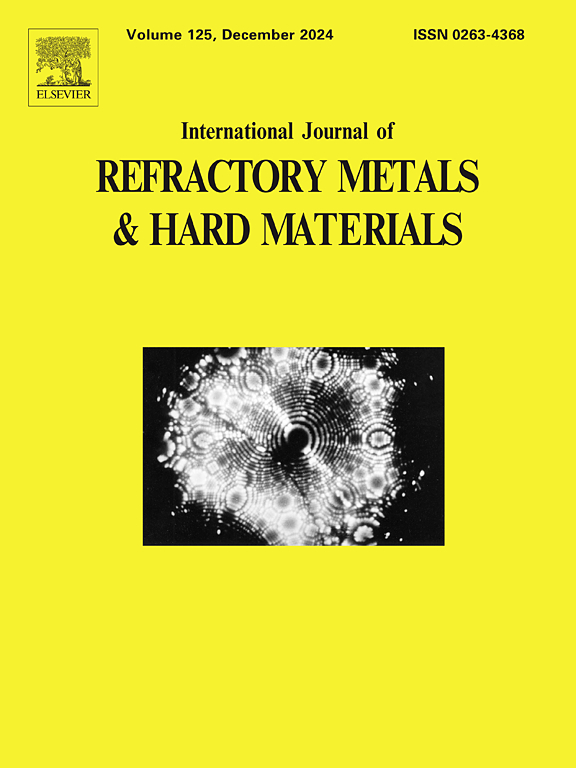A new viewpoint on the influence mechanism of TaC additions on performance of WC-Co cemented carbides
IF 4.2
2区 材料科学
Q2 MATERIALS SCIENCE, MULTIDISCIPLINARY
International Journal of Refractory Metals & Hard Materials
Pub Date : 2024-10-22
DOI:10.1016/j.ijrmhm.2024.106928
引用次数: 0
Abstract
One of the possible ways to improve performance properties of WC-Co cemented carbides for different applications is known to be adding insignificant amounts of tantalum carbide. Performance of mining tools is noticeably improved as a result of small additions of TaC, so that some companies produce WC-TaC-Co grades for mining applications. Despite clear experimental evidence of the positive influence of small TaC additions on the properties and performance of WC-Co cemented carbides, the mechanism of this influence is presently not understood. In the present work a new viewpoint of the influence mechanism of small TaC additions of performance of WC-Co cemented carbides was elaborated. It was established that small amounts of TaC added to WC-Co cemented carbides form an oversaturated solid solution of tantalum in cobalt when solidifying the liquid binder during cooling from sintering temperatures. This solid solution decomposes when further cooling in the solid state resulting in the formation of (Ta,W)C nanoplatelets and rounded nanoparticles embedded in the binder matrix. The effectiveness of cemented carbide with such a nanograin reinforced binder is assumed to be similar to that of the well-known cemented carbides with the binder reinforced by hard metastable W-Co-C nanoparticles implemented in industry about 20 years ago. The production of the cemented carbides with the (Ta,W)C nanograin reinforce binder is more economical and consistent, which ensures the more sustainable manufacture, and the nanoprecipitates are stable at elevated temperatures.

关于添加 TaC 对 WC-Co 硬质合金性能影响机制的新观点
众所周知,改善不同用途的 WC-Co 硬质合金性能的方法之一是添加少量的碳化钽。由于添加了少量的 TaC,采矿工具的性能得到了明显改善,因此一些公司生产了用于采矿的 WC-TaC-Co 牌号。尽管有明确的实验证据表明少量添加 TaC 对碳化钨-碳化钨硬质合金的特性和性能有积极影响,但目前还不清楚这种影响的机理。在本研究中,我们阐述了少量添加 TaC 对 WC-Co 硬质合金性能影响机制的新观点。研究证实,在 WC-Co 硬质合金中添加少量 TaC,会在烧结温度冷却过程中凝固液态粘结剂时形成钽在钴中的过饱和固溶体。这种固溶体在固态下进一步冷却时会发生分解,形成(Ta,W)C 纳米片和圆形纳米颗粒,嵌入粘结剂基体中。假定使用这种纳米晶粒增强粘结剂的硬质合金的效果与大约 20 年前在工业中使用的由坚硬的可转移 W-Co-C 纳米颗粒增强粘结剂的著名硬质合金的效果相似。用(Ta,W)C 纳米晶粒增强粘结剂生产硬质合金更经济、更稳定,这确保了生产的可持续性,而且纳米沉淀物在高温下也很稳定。
本文章由计算机程序翻译,如有差异,请以英文原文为准。
求助全文
约1分钟内获得全文
求助全文
来源期刊
CiteScore
7.00
自引率
13.90%
发文量
236
审稿时长
35 days
期刊介绍:
The International Journal of Refractory Metals and Hard Materials (IJRMHM) publishes original research articles concerned with all aspects of refractory metals and hard materials. Refractory metals are defined as metals with melting points higher than 1800 °C. These are tungsten, molybdenum, chromium, tantalum, niobium, hafnium, and rhenium, as well as many compounds and alloys based thereupon. Hard materials that are included in the scope of this journal are defined as materials with hardness values higher than 1000 kg/mm2, primarily intended for applications as manufacturing tools or wear resistant components in mechanical systems. Thus they encompass carbides, nitrides and borides of metals, and related compounds. A special focus of this journal is put on the family of hardmetals, which is also known as cemented tungsten carbide, and cermets which are based on titanium carbide and carbonitrides with or without a metal binder. Ceramics and superhard materials including diamond and cubic boron nitride may also be accepted provided the subject material is presented as hard materials as defined above.

 求助内容:
求助内容: 应助结果提醒方式:
应助结果提醒方式:


